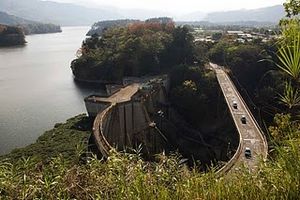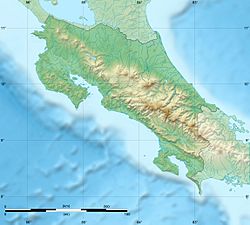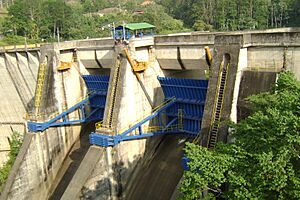Lake Cachí facts for kids
Quick facts for kids Lake CachiRepresa de Cach |
|
|---|---|

View of Lake Cachi
|
|
| Location | Costa Rica |
| Coordinates | 9°49′38″N 83°49′0″W / 9.82722°N 83.81667°W |
| Type | Artificial reservoir |
| Primary inflows | Reventazon River |
| Primary outflows | Reventazon River into Atlantic Ocean |
| Catchment area | 919 square kilometres (355 sq mi) |
| Basin countries | Costa Rica |
| Max. length | 70 metres (230 ft) |
| Surface area | 324 hectares (800 acres) |
| Average depth | 69 metres (226 ft) |
| Max. depth | 80 metres (260 ft) to deepest foundation |
| Water volume | 51 million cubic metres (41,000 acre⋅ft) |
| Surface elevation | 970 metres (3,180 ft) |
Lake Cachi (Spanish: Lago de Cachí) is an artificial lake in central Costa Rica. It was created by the Cachí Dam, a large concrete wall built across a river. This dam is located east of Cartago in Cartago Province. The main town nearby is Cachí.
The dam and lake were built in the 1970s. This was one of the first projects in Costa Rica to make electricity using water power, called hydroelectric power. The power plant at Lake Cachi can produce 102 megawatts of electricity. It uses three special machines called turbines, each making 34 megawatts.
The first part of the project started working in 1966. The second part began in 1967, and the third in 1978. The Reventazon River feeds the lake and helps in many ways. The Cachí Dam not only makes electricity but also helps control floods. It also offers fun activities at Lake Cachi. Other projects on the same river also provide power and even drinking water for a large city.
The lake is a very important source of electricity for Costa Rica. It is managed by a company called Instituto Costarricense de Electricidad (ICE).
Contents
Lake Cachi's Location
Lake Cachi is formed by the Cachí Dam. This dam is in the northeastern part of the lake, close to the village of Ujarras. It sits in the middle part of the Reventazon River valley.
The lake is created when the dam holds back the Reventazon River. The river flows through a valley with steep sides. The area that drains into the lake is about 919 square kilometres (355 sq mi). This means all the rain and water from this large area flows into Lake Cachi.
The amount of rain in this river basin can be very different, from 1,200 to 8,000 millimetres (47 to 315 in) each year. Much of the land around the lake is mountainous, with very steep slopes. On average, about 104 cubic metres per second (3,700 cu ft/s) of water flows into the lake every second.
The lake can hold about 51 million m3 (1.8 billion cu ft) of water. It covers an area of 324 hectares (800 acres) and stretches for about 6 kilometres (3.7 mi). The deepest part of the lake is around 69 metres (226 ft) deep. Most of the land around the reservoir is covered by forests, while the rest is used for farming.
Cachí Arch Dam Structure
The Cachí Dam is a special kind of concrete dam. It is called a "double-arch" dam because of its curved shape. It is known for being one of the thinnest dams of its kind in the world. The dam stands about 80 metres (260 ft) tall from its deepest base.
It is built in a narrow gorge, which is like a deep, narrow valley. The top of the dam is about 70 metres (230 ft) long. It holds back 51 million cubic metres (1.8×109 cu ft) of water from the Reventazon River.
An interesting fact is that the dam was not damaged during the 1991 Limon earthquake. Even though the earthquake happened 86 kilometres (53 mi) away, the dam stayed strong. However, the power plant, which is 12 kilometres (7.5 mi) away, had to stop making electricity for a short time because some equipment moved.
The company ICE planned and built this project. Experts from Portugal helped with the design and watched over the building process. Before construction, they carefully checked the ground to make sure it was a good place for the dam. During construction, two tunnels were built to move water away from the dam's foundation. This allowed workers to build safely.
Hydroelectric Power Plant
Water from Lake Cachi travels through a long tunnel, about 5,942 metres (19,495 ft) long. This tunnel leads to the power house. Inside the power house, there are three large machines called Francis Turbines. Each turbine can produce 34 megawatts of electricity. They are designed to work with different water levels.
The first two turbines started working in 1966 and 1967. The third one was added in 1978. The World Bank helped fund this project.
The power plant at Cachí is going to get even bigger! Its power output will increase from 100 megawatts to 160 megawatts. This expansion will include a new 40-megawatt generator. An older generator will also be improved. This work was planned to start in 2012 and finish by 2015.
Once it's expanded, the Cachí power plant will be able to provide electricity for about 330,000 people. A bank called the Central American Bank for Economic Integration (CABEI) is helping to pay for this project with a $140 million loan.
Sediment Management
Rivers naturally carry sand and dirt, called sediment. This sediment can build up in reservoirs like Lake Cachi. When the Cachí project was planned, experts estimated that about 0.81 million tons of sediment would flow into the lake each year. This amount is about 1% of the lake's storage volume.
To prevent too much sediment from building up, the dam has a special opening at the bottom. This opening, called a scouring sluice, helps flush out the sediment. For the first seven years after the dam was built, the lake was not cleaned out. This caused a lot of sediment to get trapped, which made it harder for the power plant to work properly.
To keep the lake working well, it became necessary to drain the lake to its lowest level each year. This allowed the trapped sediment to be flushed downstream. This process started in 1973 and happened every year until 1990.
Scientists have studied how well these flushing operations work. They found that the sluices are effective, especially because Lake Cachi is in a narrow gorge. However, on the flat areas around the lake, the flushing was not as effective. This was partly because water plants like water hyacinths trapped the sediment.
Today, the Cachí reservoir is cleaned of sediment almost every year. Studies in 1996 showed that about 250,000 tons of sediment were deposited downstream from the dam during these operations.
Recreation and Fun
The area around the Cachí Dam is also great for fun activities! The river below the dam has white water for about 65 kilometres (40 mi). This makes it a popular spot for rafting.
The lake itself is surrounded by beautiful mountains. It was created to provide San José with clean hydroelectric power. The scenic views and water activities make Lake Cachi a lovely place to visit.
See also
 In Spanish: Lago de Cachí para niños
In Spanish: Lago de Cachí para niños



